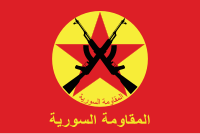This article needs to be updated. (January 2025) |
| Syrian Resistance المقاومة السورية | |
|---|---|
 Flag of the Syrian Resistance | |
| Leaders |
|
| Dates of operation | 2011[2] – ? |
| Group(s) | Falcons of the Jazira and Euphrates[3] |
| Headquarters | Latakia |
| Active regions | Syria |
| Ideology | |
| Political position | Far-left |
| Size | 2,000 (2015)[6] |
| Part of | Military Intelligence Directorate (until 2024) |
| Allies | |
| Opponents | |
| Battles and wars | Syrian Civil War
|
| Insignia (SSI) |  |
The Syrian Resistance (Arabic: المقاومة السورية, romanized: al-Muqāwamat al-Sūriyah), formerly known as the Popular Front for the Liberation of the Sanjak of Iskandarun (Arabic: الجبهة الشعبية لتحرير لواء اســكندرون), is a Marxist-Leninist pro-Assad militia that operates in northwest Syria.
Background
[edit]The movement is led by Mihrac Ural, a Turkish Alawite who has Syrian citizenship[8] and is also known as "Ali Kayyali" (علي كيالي).[5][9] According to Today's Zaman, Ural was the leader of a clandestine insurgent cell in Hatay Province called the People's Liberation Party-Front of Turkey or Acilciler (The Urgentists). Zaman further alleged that Ural's group has sought to agitate Hatay's sizable Alawite population into confrontation with the Turkish authorities and has also recruited local Alawites to fight in Syria on behalf of the Syrian government.[10] The group claims to also have supporters among Syria's Sunni Muslims and Christians.[5]
Though the group openly espouses a broadly-inclusive platform of Syrian nationalism in addition to secular leftism, it has been claimed that its primary focus is the defence of the Alawite and Twelver Shi’a religious minorities of Syria.[5] The Syrian Resistance has been accused by the Syrian opposition of being a sectarian Alawite militia, and of having carried out bombings and attacks in Turkey and on villages in Syria. However, Sheikh Muwaffaq al-Ghazal, a member of the Islamic Alawi Council, claims it has an inclusive national line regarding religion, race and gender.[11]
History
[edit]Founded before the Syrian Civil War's outbreak under the name "Popular Front for the Liberation of the Sanjak of Iskandarun", the militia has been most active in Latakia Governorate,[5] where its members reportedly committed a massacre in the town of Baniyas in 2013. The Turkish government has also suspected the Syrian Resistance of carrying out the Reyhanlı bombings.[12]
On 29 March 2016, it was falsely reported[12] that Mihraç Ural had been killed by Ahrar al-Sham.[13][14]
In late July 2016, the Syrian Resistance sent reinforcement contingents from Hama to Aleppo in order to support the pro-government forces during the 2016 Aleppo campaign. In course of the campaign, they were deployed both in the northern city at the Castello road front, as well as in the south where rebel forces launched a counter-offensive.[7]
At some point, the "Falcons of the Jazira and Euphrates", a militia of Deir ez-Zor Governorate natives, officially joined the Syrian Resistance, though it remained operationally fully autonomous. Under the Syrian Resistance's flag, this unit took part in the central Syria campaign of mid-2017.[3]
Jamal Trabelsi, director of the Syrian Resistance's information office, was targeted by an improvised explosive device (IED) in Aleppo in July 2017, though he survived. The group accused "Turkey-backed & hired gangs" of being behind the attack.[1] A few days later, a female media officer of the Syrian Resistance, Duaa Hayel Sulaiman, was assassinated in Damascus.[15]
See also
[edit]References
[edit]- ^ a b "IED targets a leader of the Syrian regime-allied militia of Iskenderun Liberation Front". Al-Dorar Al-Shamia. 23 July 2017. Archived from the original on 21 June 2019. Retrieved 28 August 2017.
- ^ Lund, Aron (23 July 2013). "Gangs of Latakia: The Militiafication of the Assad Regime". Syria Comment. Retrieved 24 July 2013.
- ^ a b c Aymenn Jawad Al-Tamimi (10 August 2017). "Suqur al-Furat: A Pro-Assad Sha'itat Tribal Militia". Retrieved 28 August 2017.
- ^ Fadel, Leith. "Syrian Army Captures Final Oil Well at Al-Sha'ar; Nusra Losing Ground in Idlib". Al Masdar News. Archived from the original on 4 March 2016. Retrieved 3 August 2013.
- ^ a b c d e f g h i j al-Tamimi, Aymenn Jawad (22 September 2013). "A Case Study of "The Syrian Resistance," a Pro-Assad Militia Force". Syria Comment. Retrieved 24 September 2013.
- ^ Albayrak, Aydin. "Mihraç Ural, a man with a long history of terrorism". Today's Zaman. Archived from the original on 28 August 2017. Retrieved 28 July 2015.
- ^ a b Aymenn Jawad Al-Tamimi (3 September 2016). "Quwat Dir' Al-Amn Al-Askari: A Latakia Military Intelligence Militia". Syria Comment. Retrieved 3 September 2016.
- ^ "Mihraç Ural, a man with a long history of terrorism". Todayszaman.com. 14 May 2013. Archived from the original on 4 March 2016. Retrieved 11 December 2013.
- ^ far (April 2016). "مصادر أمنية تركية تؤكد مقتل معراج أورال في ريف اللاذقية". القدس العربي Alquds Newspaper. Retrieved 4 May 2016.
- ^ "Group tries to recruit Hatay Alevis into Assad army". Today's Zaman. 3 September 2012. Archived from the original on 28 April 2014. Retrieved 28 April 2014.
- ^ "Syria: Secularism Takes a Backseat in Latakia". Al Akhbar English. 11 May 2013. Archived from the original on 12 November 2014. Retrieved 11 December 2013.
- ^ a b Alsouria Net (2 February 2018). "Turkey Furious Over Attendance of 'Butcher of Baniyas' at Sochi". The Syrian Observer. Retrieved 3 February 2018.
- ^ "Mihraç Ural, top terrorist sought by Turkey fighting in Assad regime ranks, killed in clashes in Syria". DailySabah. 29 March 2016. Archived from the original on 11 July 2016. Retrieved 4 May 2016.
- ^ "Death of Mihrac Ural not yet confirmed: militia, regime SYRIA NEWS - ZAMAN ALWSL". SYRIA NEWS - ZAMAN ALWSL. Retrieved 4 May 2016.
- ^ "Media woman Killed under mysterious circumstances". Al-Dorar Al-Shamia. 26 July 2017. Archived from the original on 21 June 2019. Retrieved 28 August 2017.
External links
[edit]- Syrian Resistance on Facebook (in Arabic)
- THKP-C Acilciler blog